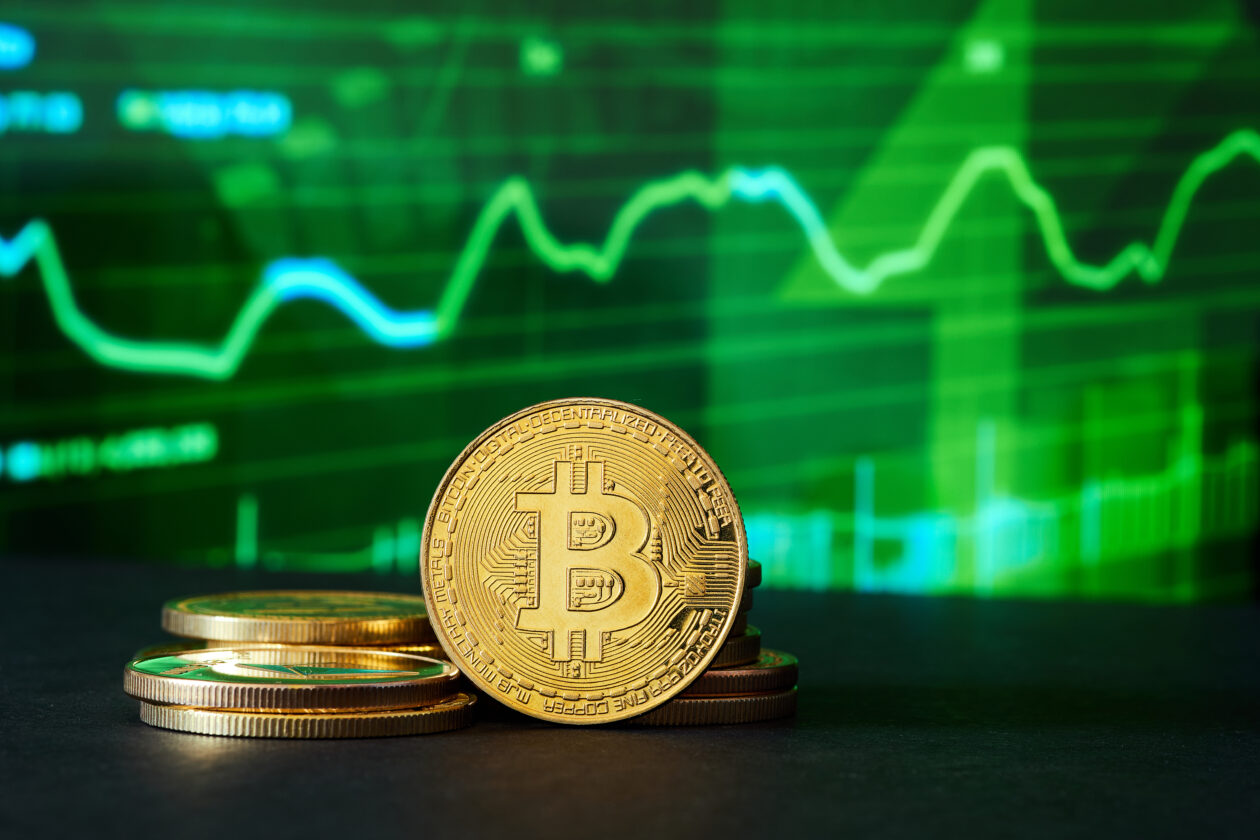Bitcoin rose in Friday afternoon trading in Asia, a day after asset management firm BlackRock provided a timely fillip to the digital asset industry by filing to launch an exchange-traded fund (ETF) for the cryptocurrency. Ether and most other top 10 non-stablecoin cryptos rose, with the exception of Polygon and Tron. Meanwhile, global markets are seeing some upside after the U.S. Federal Reserve’s decision to pause interest rate hikes.
See related article: Asia lays out a welcome mat for crypto, while US bars its door
Bitcoin receives timely boost
Bitcoin rose 2.43% to US$25,515 in the 24 hours to 4 p.m. in Hong Kong, but lost 3.70% over the last seven days, according to CoinMarketCap data. The world’s biggest cryptocurrency also saw its market capitalization rise 2.40% to US$495.71 billion in the last 24 hours.
Some of that positive movement came on the back of the announcement late Thursday that the world’s biggest asset manager, BlackRock, intends to launch the first publicly traded U.S.-based Bitcoin exchange-traded fund (ETF). Coinbase Custody Trust Co. will act as the custodian for the company’s Bitcoin.
The ETF, if approved, will be listed on the Nasdaq stock exchange.
And @coinbase is in fact the custodian pic.twitter.com/eCKKgjsKDx
— Eric Balchunas (@EricBalchunas) June 15, 2023
Bitcoin dropped to US$24,909 on Thursday afternoon in Asia for the first time since March 17 this year. It then rallied to a high of US$25,700 in the hour after the BlackRrock announcement, before reverting back to the US$25,500 mark.
Ether, the second-biggest cryptocurrency by market capitalization, also rose 2.12% to US$1,669 over the past 24 hours, but is down 9.09% for the week.
Litecoin was the biggest gainer in the last 24 hours, rising 3.62% to US$75.22, although it is down 14.09% on the week.
Polygon and Tron were the only losers among top 10 non-stablecoin cryptos. Polygon’s Matic token dropped 4.07% to US$0.5896, bringing its weekly losses to 23.85%.
Tron lost 1.95% to US$0.06986 in 24 hours and 9.81% over the last week.
BNB, the native token of world’s biggest crypto exchange Binance, rose 1.43% to US$239.19, but its weekly losses stood at 7.36%.
“Binance Coin (BNB) is testing the critical US$220/200 level and IF this level breaks, there could be severe consequences on sentiment,” said Markus Thielen, Head of Research & Strategy at digital asset service platform Matrixport, in an emailed statement.
The U.S. SEC filed lawsuits against crypto exchanges Binance.US and Coinbase in the week of June 5. Doing so, it named several altcoins as financial securities, including Solana, Cardano, Polygon and BNB.
“There is now a real possibility that the altcoins from the 2020/21 bull market will never reach new all-time highs again,” Thielen said.
“Unless the investor is a trader with risk management skills, parking their crypto exposure in Bitcoin might be the only sensible option until a new bull market emerges that carries more weight than simply favorable macro tailwinds, and until the regulatory overhang diminishes,” he added.
U.S.-based trading platform Robinhood will delist Cardano, Polygon and Solana from June 27, after the SEC labeled them as unregistered securities. This has caused their prices and market capitalization to take a beating.
The three tokens combined had a market capitalization of US$20.6 billion as of Friday afternoon in Asia. That figure is a drop of 29.4% from the US$29.18 billion prior to the SEC’s lawsuits. The severe drop is a sign of liquidity leaving the industry.
“Early in the week, there was hope that the back-to-back U.S. CPI (consumer price index) and Fed rate pause would boost the markets, but that did not happen,” said Le Shi, Head of Trading at crypto trading firm Auros.
“A clear divergence in the fortunes of U.S. equities compared to the crypto market after these events made it clear that traders were more concerned with regulatory risk than any expected macro tailwinds arising from the Fed rate pause or softening CPI,” Shi added.
The global crypto market capitalization rose 1.96% to US$1.04 trillion, while total market volume dropped 14.98% to US$32.52 billion in the last 24 hours.
NFTs stay down
In the non-fungible token (NFT) market, the Forkast 500 NFT index dropped 0.84% to 2,883.08 in the past 24 hours, bringing its weekly losses to 10.48%.
The Forkast ETH NFT Composite also dropped 0.96% to 1,019.86 in 24 hours, and lost 7.30% over the last week. Transactions on Ethereum, the leading NFT blockchain, dropped 10.10% to US$13.25 million in the last 24 hours. In the same period, transactions on the Bitcoin network, the second largest NFT blockchain, plunged 10.52% to US$1.42 million.
On Thursday, global auction house Sotheby’s finished its second round of sales of NFTs from the “Grails” collection. The auction saw US$10.9 million in sales, over half of which was from Dmitri Cherniak’s Ringers #879 – often referred to as “The Goose” – which sold for US$6.2 million.
#AuctionUpdate: One of the most important works of post-blockchain generative art,@dmitricherniak’s Ringers #879 (The Goose) has just sold for $6.2 million, making it the 2nd highest generative art sale of all time. #SothebysGRAILS https://t.co/dKyqxGbAIZ pic.twitter.com/zkxoP21M9e
— Sotheby's Metaverse (@Sothebysverse) June 15, 2023
“Sentiment is rather high following the success of Sotheby’s auction of historic NFTs yesterday, and combined with news that BlackRock is filing for a Bitcoin ETF, there’s hope this can inject life back into NFTs,” said Yehudah Petscher, NFT Strategist at Forkast Labs.
“It’s worth noting that the supposed buyer was already a major NFT trader, so this auction didn’t seem to draw attention from the traditional art world,” Petscher said about the auction.
“Is it bullish still for NFT art? Yes, but there’s still always concern that the NFT ecosystem is largely an echochamber,” he added.
Elsewhere, despite the latest round of legal charges leveled against former U.S. President Donald Trump, the Trump Digital Trading Cards project is gaining momentum. It has begun redeeming prize NFTs in exchange for physical prizes.
The prizes include signed books, gift cards, golf tickets, zoom calls with the former president and even a gala dinner at Trump’s Florida home Mar-a-Lago.
Asian, European equities rise; U.S. stock futures mixed

Asian equity markets rallied on Friday with sense that U.S. interest rates could be reaching their peak. Markets were also optimistic after China’s central bank lowered medium term lending rates on Thursday. The Bank of Japan (BOJ) on Friday decided to maintain its ultra-loose monetary policy. As widely anticipated, the central bank will leave its short-term interest rate unchanged at -0.1% and 10-year bond yields at around 0%.
“With extremely high uncertainties surrounding economies and financial markets at home and abroad, the Bank will patiently continue with monetary easing while nimbly responding to developments in economic activity and prices as well as financial conditions,” the BOJ said in its statement on monetary policy released Friday.
By the close of afternoon trading, the Shanghai Composite had gained 0.63% while the Shenzhen Component Index rose 1.11%. Hong Kong’s Hang Seng Index climbed 1.07% and Japan’s Nikkei 225 strengthened 0.66%.
European equity markets gained on Friday as investors digested the recent interest rate decisions from major central banks. The European Central Bank (ECB) raised interest rates by 25 basis points on Thursday to 3.5%, while both the ECB and the U.S. central bank suggested more rate hikes are on the way later in the year.
The benchmark STOXX 600 gained 0.45% and Germany’s DAX 40 climbed 0.16% during afternoon trading hours in Europe.
U.S. stock futures were trading flat as of 6.30 p.m. in Hong Kong. The Dow Jones Industrial Average futures gained 0.01%, and S&P 500 futures dropped 0.01%. Nasdaq 100 Futures gained 0.03%.
Interest rates in the world’s biggest economy remain at 5% to 5.25% after the U.S. Federal Reserve decided against a further raise at its June meeting earlier this week. The rate is at its highest since 2006 after ten consecutive hikes that started in March 2022. The hikes were made to combat persistent inflation, which had pushed to a 40-year high at one point last year.
“The Fed’s primary goal is price stability. With that goal in mind and inflation where it currently stands, a rate hike would have been the more appropriate choice,” Michiel Janssen, trader and analyst at crypto hedge fund AltTab Capital, said in an email statement.
“But the Fed is also taking into account the time the market needs to adjust to the higher rates. The banking failures are proof that the fastest ever increase in the Fed rates are causing stresses in the financial system,” Janssen said.
The next Federal Open Market Committee meeting is scheduled for July 25 to 26. The U.S. central bank has signaled two more rate hikes by the end of 2023, to bring inflation down to its target level of 2%.
“The Fed will indeed raise rates in July, with the obvious caveat that a deterioration in inflation or employment data could make the Fed more inclined to hold rates steady for another meeting,” said Frances Donald, Chief Economist at wealth management firm Manulife Investment Management, in an emailed statement.
“We have fairly high conviction that U.S. headline inflation will fall to around 3% by year end… we think the more important question for investors is how and when the central bank will respond to the expected slowdown in U.S. growth,” Donald added.






